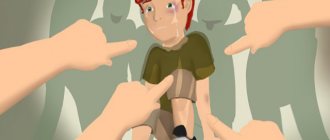Verbal signs of lying
Most people perceive the art of detecting lies as the ability to read body movements and decipher facial expressions. This is partly true, but there is another side to this activity. What we say - the meaning of speech - can also be used to reveal deception. Later in the article we will look at verbal signs of lying.
How does lying affect verbal behavior?
There are three main factors influencing a liar that make it possible to expose him: emotions, attempts to control the situation, and the cognitive load caused by the need to process larger amounts of information than when telling the truth. All of them affect the verbal part of communication, as a result of which we can notice quite specific changes.
As in the study of nonverbal behavior, there are no signs that would clearly indicate a lie, except in cases where it is deliberate. It is necessary to take into account all possible explanations for such behavior and draw a conclusion about lies only when discarding other options.
Emotions
Most often, liars feel guilty about their deception, especially if it concerns people significant to them. In addition, another common emotion is fear of exposure. As a psychological defense, liars try to abstract themselves from their words. This is manifested in the following verbal signs of lying:
- indirect, evasive answers;
- overly generalized information;
- the answers do not contain self-references (references to oneself) - words such as “I”, “me”, “me”, etc.
Persistent questions, fear, feelings of guilt - all this can cause irritation in the liar, as well as attempts to avoid continuing communication. Manifestations of irritation can be negative, denying statements. For example, instead of saying: “I am an honest person,” a liar will say: “I am not a fraud.” Reluctance to further communication is manifested by short, evasive phrases and monosyllabic answers.
Controlling the situation
A feature of the behavior of liars is that they do not adequately assess the situation, which is associated with both an abundance of conflicting emotions and cognitive difficulties. This explains their attempts to make a more favorable impression on their listeners. A verbal manifestation of this may be the communication of irrelevant information. For example, when asked “where were you this evening,” a liar will limit himself to a short, evasive answer and immediately move on to colorful descriptions of the weather or traffic difficulties.
Increased cognitive load
The need to lie, hide your true emotions, or mask them with pretend ones, requires much more stress from the brain. This is especially evident during spontaneous lies, when you have to invent them right during the conversation.
In this case, the deceiver’s story will be short and generalized. It may sound implausible. There will also be little personal characteristics, experiences, or self-references.
Restrictions
It should be noted that verbal behavior is much more controllable than nonverbal behavior. Liars who are aware of the above features of deception can adjust their speech quite well. In addition, more educated and articulate people are less likely to verbally leak.
conclusions
Learning to take into account verbal signs of deception is a very promising tool in the profiler’s arsenal. Most liars tend to give generalized, evasive, and short answers that contain minimal self-references. They also prefer to switch to unimportant, but well-known details. Often their stories are implausible or provide irrelevant information.
Did you like the article? Join our communities on social networks or our Telegram channel and don’t miss the release of new useful materials: TelegramVKontakteFacebook
We also recommend reading:
- Storytelling
- The Brokaw Trap and Lie Detection
- Social perception
- 10 Commandments of a Profiler
- 7 basic recommendations for detecting lies
- Neurobiology of Nonverbal Communication
- Lie detection methods
- How to Reduce Cognitive Load in Learning
- Is it easy to spot a lie?
- Brain digest
- 3 Effective Ways to Detect Lies
Key words:1Profiling
GuruTest
People would lie less if they knew that the words they spoke betrayed them. Why are there so many liars? The answer is surprisingly simple: we do not try to see and recognize lies. This is why there are so many liars and their victims around.
Professor Paul Ekman in his scientific publication pays special attention to behavioral signs and speech, considering them the most accurate information channels. In his opinion, deceivers do not hide all aspects of their lies and cannot do this even if they want to. No one can control everything that can reveal his lies. Therefore, people only falsify what others will observe much more closely. So, especially for readers of the site gurutest.ru - the main mistakes of liars.
Mistake one: emotions . Facial expressions are one of the main forms of manifestation of feelings, which allows you to see many, even carefully hidden emotions. The most striking confirmation of this can be found in a situation when the person who gave you a compliment only after that puts a smile on his face. The non-simultaneity of words and emotions betrays a lie.
Mistake two: unnecessary details . Did the person tell you in general terms the essence of the current situation and, noticing your doubts, immediately began adding details? Rest assured, he is lying. Focusing on minutiae is a trick that adds credibility to a fake story. Usually the details that are emphasized are completely meaningless in the conversation and are not relevant.
Error three: left side . It is impossible to completely control your body, especially the left side. So when you want to know if a person is being honest with you, take a closer look at the wild side of our body. If, during communication, the opponent’s left arm or leg begins to move chaotically, this indicates nervous excitement, which is caused by an unwillingness to tell the truth. The left side shows real feelings, emotions and experiences, so identifying a lie is not so difficult.
Mistake four: sarcasm or humor . The liar's move is to defend against your doubts through sarcasm, humor, or assertiveness. You just expressed your indignation when you immediately heard a sharp remark, reproach or joke addressed to you? Take a closer look at the person: this is a clear signal that the liar has gone on an active offensive.
Mistake five: composure . A liar watches closely the reaction of the person he is trying to fool. For him, the slightest change in a person’s facial expression is a signal that it’s time to change tactics or, conversely, tie up fishing rods. He is very tense and attentive: he needs to understand whether you have swallowed the bait or not. A person who tells the truth is usually passionate about his story.
Mistake six: brevity . When a person is about to lie, he usually has little time to think, so his false story is often short and concise. You are unlikely to hear a detailed and detailed answer to your question from a professional manipulator. Brevity is necessary to clearly present your version, get rid of tension and evaluate the reaction of your interlocutor.
Mistake seven: speech . When communicating with a pathological liar, you can find many understatements, confusion, and factual errors. He speaks quickly and confusedly, his speech becomes crumpled, and his pace either slows down or speeds up. At first, a person may speak slowly, but as the story progresses, out of fear of being caught red-handed, he begins to speed up. These fluctuations are hard to miss. In addition, to make things easier for themselves, the deceiver often repeats your words.
Mistake eight: hands near your face. Gestures that indicate a lie are covering your mouth with your hand, touching your nose, scratching your neck, eye or back of your head, covering your ear, touching your chin. Such manners, when repeated many times, simply scream that the person is lying. Of course, some gestures may be unique to your opponent. However, if you have not noticed anything like this before, then it makes sense to think about whether they are trying to deceive you.
Mistake nine: incoherence . If you are not sure of the veracity of the words, ask the person to retell the story from the end. Anyone who tells you the truth will do it with ease. But a liar can immediately refuse or agree, but begin to get confused in the “testimony”. Another important point: in the liar’s stories you can find many inconsistencies in dates, times, and places.
Mistake ten: glance. It is widely known that the eyes are the mirror of the soul. It’s easy to tell by the eyes whether your interlocutor is lying to you or not. Unclean people usually do not look directly at their opponent, preferring to look away to the side, at the floor or walls.
Mistake eleven: generalization . In their words, deceitful people use the so-called expressions of universality: “everyone”, “always”, “nobody”, “never”. In this way, they try to inflate their lies, this is especially noticeable when answering specific and testing questions.
A person’s behavior and speech are the most important indicators of truthfulness or lies. It is necessary to focus attention on the general structure of speech, as well as on frequent speech evasions, slips of the tongue and careless gestures. All this will help you get off the hook of the manipulator painlessly. be careful
Our Yandex.Zen channel always has the most interesting articles on this topic. Be sure to subscribe!
13.06.2019 04:02
Refrain from hasty conclusions
When interpreting the behavioral characteristics described above, be very careful. Identified signs of lying may actually indicate the insecurity of your interlocutor.
The absence of signals of lies is not yet proof of the truth. The deceiver may simply not allow a single rash gesture. People often make mistakes when they first meet. This is due to the lack of ability to detect unusual behavior of the opponent. For example, a person gestures vigorously with his left hand. You know that this is one of the nonverbal signs of lying, and you begin to suspect it. In fact, it turns out that this person is left-handed, and he is only using his dominant hand.
Consider whether you have any prejudices against the alleged liar. Don't jump to conclusions if you dislike a person.
It is assumed that the change in voice may be a consequence of frustration or remorse. But this has not yet been proven. In addition, scientists have not yet determined whether the tone of a person who is delighted with a successful deception changes.
It must be taken into account that not only liars, but also completely innocent individuals can experience emotional arousal.
Covering your mouth
When trying to identify signs of lying, observe the movements of the interlocutor. By recognizing characteristic gestures, you can understand that you are being deceived. Thus, liars often cover their mouths with their hands. Young children do this openly, as if trying to stop the lying words. As people get older, this gesture becomes less noticeable, but still occurs. If you notice how your interlocutor made this movement, begin to carefully observe him. The gesture discussed above should be taken into account in conjunction with others. Covering your mouth with your hand once does not mean anything specific.
How can you tell if a person is lying?
Let us highlight the main channels through which you can bring the deceiver to clean water.
Verbal indicators:
- voice, intonation;
- verbal context and content.
Non-verbal:
- eyes;
- facial expressions;
- hand gestures, body language.
It is worth remembering that any look, gesture or any word can have several interpretations. Therefore, it is not enough to study the signs listed below, since they can only be applied to an interlocutor with whom you have a long history of communication.
How to recognize a lie by the eyes
- Avoiding eye contact
A liar will often try to avoid eye contact. Typically, most of the time - 60-80% - his gaze will supposedly evaluate the surrounding situation, raised up - thinking about something, or down - “looking at something interesting.”
- Frequent blinking
If a person does not have problems with his eyes, then frequent blinking indicates his excitement. Does he have a reason for this? If not, then most likely what he is saying is a lie.
- Fake surprise
When a person is sincerely surprised, his eyebrows rise. If a person just wants to pretend that he is glad to see you, then his intonation in his voice will only increase.
How to recognize lies by voice and speech
- High pitched voice
During a conversation, the person who wants to deceive you cannot fully control himself. His attention is scattered over many things so as not to give away his deception. That's why the tone of his voice changes from time to time: because of this inner turmoil.
When a person lies - and even more so ineptly - his emotions simply rage. It's like he's walking through a minefield. Therefore, you can determine by the voice what state the interlocutor is in: if he has high notes, most likely he is hiding something; if he speaks in a calm, low voice, he is most likely telling the truth.
- Pauses in speech
As mentioned above, a liar's attention is very unfocused. And since he attaches special importance to words - a person uninitiated in the science of lies looks at what he says, and not how - he needs time to pick them up.
At this time pauses are formed. These may not be 2, 3 or 5 seconds, but barely noticeable stops. Therefore, pay close attention to how the person speaks.
- Inconsistency between what a person says and how he expresses it
This point could be attributed to a change in the tone of voice, but here another element is added - facial expressions. We'll talk about it further. Here we will give just an example to make it clear what we are talking about:
If a person, having received a gift or a compliment, begins to enthusiastically thank you, but at certain points on his face it is clear that he did not care, he is lying.
- Little detail in the story
A liar's story usually contains little detail. If you ask him to clarify something, he will have to strain very hard. And, most likely, there will be a pause after your question. Use this as an identifier. Jump from topic to topic, and then ask them to repeat the details of what you talked about a few minutes ago. But just do it naturally so as not to arouse suspicion.
- Repeat question
In order to gain time, the person repeats the question that was asked to him. These few seconds are usually enough to come up with a worthy answer: the one that is most similar to the truth.
- Repeating the same information
A liar will try in every possible way to plant his innocence in your head. And he will repeat this under different formulations.
Remember: the innocent have no excuses.
Gestures of deception
Touching your nose during a conversation is a sign of deception.
Let's figure out how you can understand from a person's actions that he is deceiving; we recognize lies by gestures.
- During a conversation, the interlocutor touches his face.
- When talking, an individual involuntarily tries to cover his mouth with his hands. In essence, he is trying to close it so that the lie does not come out.
- Touches the nose, earlobes.
- While talking to you, the individual begins to rub his eye.
- Gestures widely with hands when it is inappropriate.
- He behaves stiffly, his movements are constrained. There are practically no gestures. Perhaps he is ashamed of his deception. Or he is afraid to give himself away with any movement.
However, you need to understand that gestures alone cannot be the only criterion for identifying a liar. The fact is that a person can rub his eye, for example, because he wants to sleep or something has gotten there, or an eyelash has bent. This is not always a sign of deception.
Physiology and body language
- Profuse sweating. If you know that the person you are talking to does not sweat in everyday life, and you notice that in a particular conversation he is sweating a lot, you may be being deceived. Although it is possible that he got sick.
- Head nods. When asking your interlocutor a question that may have a one-word answer, watch his reaction. If he answers “yes” but at the same time waves his head from side to side, he does not agree with his words. If he says “no” and nods at that moment, he’s lying.
- Fidgety behavior, nervousness, inability to sit still, or unusual posture may indicate that the person is not sincere.
- A person who tells the truth is turned towards his interlocutor and may lean towards him during a conversation. If he cheats, on the contrary, he will move away.
- Rapid breathing and frequent swallowing of saliva may also indicate that a person is deceiving and is worried that his lie will be discovered.
- Crossed arms. First of all, such phenomena indicate a feeling of discomfort. Perhaps the interlocutor is in danger from the environment, in this way he protects himself. However, if such a manifestation occurs at the moment of answering the question posed, most likely he is lying. If he stood with his arms crossed during the entire conversation, it is possible that he was simply cold or did not feel openness towards you, perhaps he did not trust you.
- Half a turn. If an individual turns slightly in the other direction or turns his head to the side while answering a question, he may be lying.
- Hands in pockets. An individual may hide his hands or put them behind his back when he is insincere.










